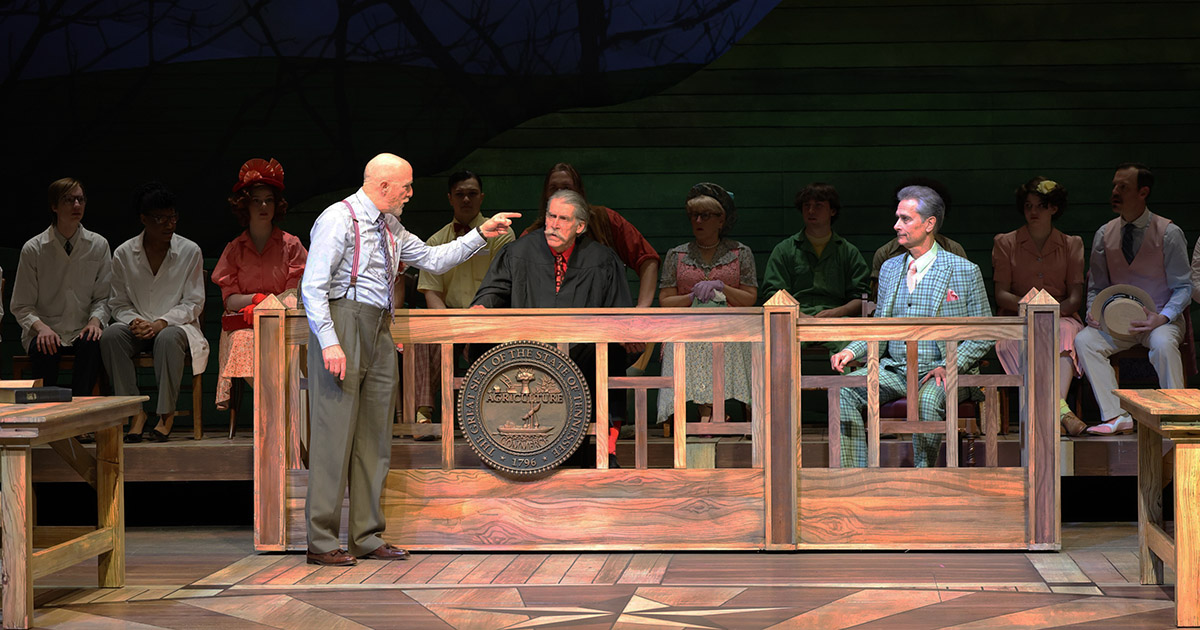One might think that coming to grips with the Clarence Brown Theatre’s latest production, an intensely provocative staging of Inherit the Wind, would be an easy task. In truth, as theatre-goers in 2025, we often struggle with the image that a dramatic mirror reflects for us. The 1955 play by Jerome Lawrence and Robert E. Lee is a fictionalized take on the 1925 “Scopes Monkey Trial” in Dayton, Tennessee, and as such, cannot avoid the obvious plot debate of science vs. religion that shamefully defined the original trial. The playwrights, though, were anxious to broaden their premise so that it encompass more dramatic territory—in this case, the freedom to think without fear. Current day issues were also a factor. At the time of the play’s writing, the evils of the “Red Scare” and McCarthyism were clearly on the playwrights’ minds; their script notes state: “It is not 1925. The stage directions set the time as ‘Not too long ago.’ It might have been yesterday. It could be tomorrow.” Audiences in 2025 will be bringing their own current experiences with them and perhaps will consider it a cautionary tale.
The play’s parallels to the historic trial are transparent. John Scopes has become Bertram Cates (Clay Cooper), a young, somewhat meek biology teacher in fictional Hillsboro, Tennessee, who has been arrested for violating a Tennessee state statute that makes teaching evolution a crime. In the bigger picture, both sides have sought a trial to bring the issue into the revealing spotlight of public awareness. Heading the prosecution of Cates is Matthew Harrison Brady, paralleling real-life William Jennings Bryan who was opposed by noted attorney Clarence Darrow, pictured here as the feared defense attorney, Henry Drummond. Drummond’s presence is being paid for by the Baltimore Herald as a way of giving the issue attention. That newspaper has sent the acerbic critic E.K. Hornbeck, paralleling writer H.L. Mencken, to cover the trial.
To achieve the intended broader viewpoint, director Katie Lupica and her creative staff have taken a visual approach that makes the play’s location in time nostalgic, but also amusingly metaphorical. The show curtain is a painted scrim that suggests a postcard image of Hillsboro from some undetermined time; Michaela Lochen’s attractive set of movable wooden slats and beams are similarly whimsically generic. The townspeople are costumed by designer Kaelyn Marie in clothing that is a fanciful mix of varying vintage styles and barely muted Kodachrome colors. The character of Brady has been given the maximum treatment, his clothing almost cartoonish in style and color. As an interesting contrast, Bertram Cates and his pro-evolution defenders, Drummond and Hornbeck, are clad in simple, non-ostentatious business style.

Leading the sizable cast were two CBT veterans in the opposing roles, Jed Diamond as Henry Drummond, and Terry Weber as Matthew Harrison Brady. Diamond has painted his character with bold strokes of wisdom and experience shaded with cynicism, his primary tools being intellect, logic, and language. On the other side, Weber has the onerous job of constructing an unsympathetic character that has, nevertheless, lived a notable life, but a life that bristles with self-righteousness and the thorns of religious rigidity. Weber has filled his character with a self-consuming hubris, making it a life that inevitably fails because of it.
The intertwining and intractability of political and religious fundamentalism is also a trait belonging to the local Reverend, Jeremiah Brown (Brian Robinson), but it is his school teacher daughter Rachel (Develyn Jayan), who as Cates’ girlfriend, is caught in the difficult to portray conflict between what she has been taught by her father and her own romantic loyalty to her friend. It is Rachel’s character arc that answers the play’s key questions about freedom of thought.
Jeb Burris, a recently added member of the UT Theatre faculty making a CBT debut, brought a fresh, kinetic energy to his role of E. K. Hornbeck, moving about the stage with an intention that underlined his character’s disdain for simple-minded townspeople that accept what they are told without questioning. Also making a secondary role into a real dynamic character was David Crawford as the town Mayor, also a UT Theatre faculty member.
Director Lupica has tinged the seriousness of the trial drama with bits of comic relief, first from the light-hearted mockery of the townspeople, then later with the support role of Meeker, the court bailiff, taken here by Doug James. Using his bumbling gait as a comic sight gag, James offered up a character in the grand tradition of operatic comic relief. In terms of visual metaphors, lighting designer Mitch Wilson painted with a broad brush, purposefully avoiding shadowy drama that could have nudged the production in an alternative direction. Amoirie Perteet’s music and sound echoed this subtle and supportive approach.
In a perfect world, audiences would leave a production like Clarence Brown Theatre’s Inherit the Wind, charmed by it as a history story of a curious time gone by. As it turns out, though, the battle for freedom of thought and expression is apparently a universal one—and one that continues.
By Jerome Lawrence and Robert E. Lee
Clarence Brown Theatre
Through March 2, 2025
TICKETS







I placed order for two tickets performance Saturday February 22, 2025 @7:30 pm via Ticketmaster online. Process took nearly 20 minutes to complete. Ticketmaster required me to change my password. Received confirmation password updated but never received any confirmation from email of the ticket purchase. After waiting several days, tried to purchase tickets again. Now ticket price is 3 times higher. Ticketmaster stinks. Will call worked.